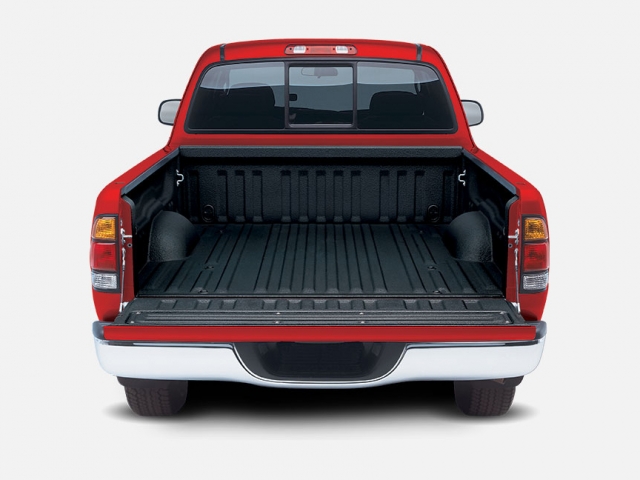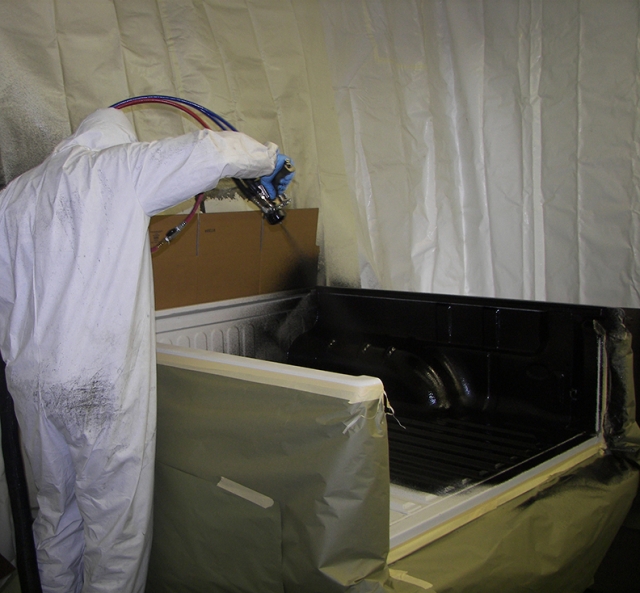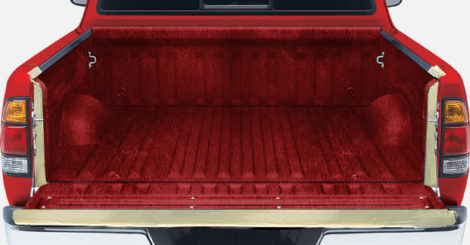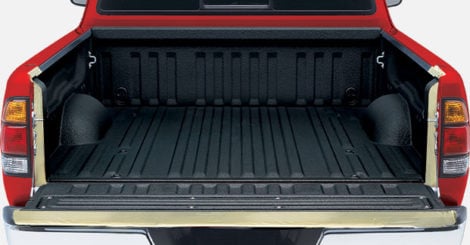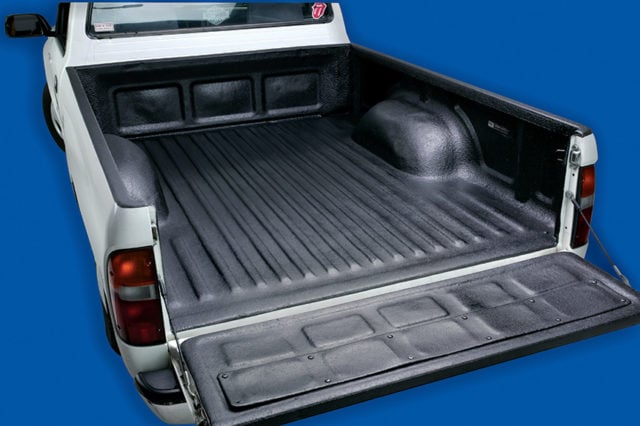The bed of a pickup truck is probably one of the most abused parts of a truck. After all, it is designed to haul just about anything. There are a few options out there to protect the bed. Some companies make thick rubber mats to protect the bottom of the bed from damage. Depending on how you use your truck that might be all you need. Another very common option in many new trucks (less now than say a decade ago) is a plastic bedliner that rides on the inside of the bed and projects the bed from damage. The biggest downside to these bedliners is the damage they actually cause themselves. These liners rub the paint off the bed of the truck and basically help rust get a foothold.
One of the best options to protecting the bed of a truck is a spray or roll on bedliner. These actually adhere to the bed and create a protective layer that bonds with the paint and metal. While these are considered permanent, they do no damage to the truck and offer a great deal of protection. We thought we would take a deeper look at bedliners so that we could offer a little better understanding as to what they are, the differences between them, and how to take care of them. For that we reached out to PEAK HERCULINER [1], Line-X [2] and Rhino Linings Corporation [3].
Understanding The Differences
Polyurea coatings are hard and have a high tensile strength that resists abrasion and tearing but are not very flexible.
Polyurethane coatings are usually more flexible and much softer than polyurea coatings. But similar to polyurea coatings, polyurethane coatings also provide great protection from damage such as tearing, gouging and puncturing.
Aromatic is a term used to describe the shape of the compound (organic chemistry) that is basically the shape of a ring. These isocyanates are used in polyurethane foams, elastomers, adhesives and coatings. Aromatic isocyanates are under catalyzed conditions extremely fast cure time.
Aliphatic is also a term used to describe the shape of the compound (organic chemistry) with the shape of them being either straight or branched. They are used predominately in coating applications because they produce polyurethanes with excellent UV resistance and exterior durability. Compared to Aromatics, Aliphatics have a slower cure time.
Bedliners can be broken down into three main types; hot or high pressure, cold or low pressure, and DIY (Do It Yourself). “A high pressure or hot spray is actually referring to the temperature of the product not the air temperature as some may think,” says Tom Cholke, Senior Technical Services Manager for PEAK HERCULINER [5]. “The warmer the product is, the shorter the curing time. That also means the colder the product is the longer it will take to fully cure.”
Even within these three main types there are different subsets of elastomers used to create the end product. “Most spray-on bedliners are either 100% polyurethane, 100% polyurea, or a hybrid of both polyurethane and polyurea. A pure polyurea bedliner achieves high results in important factors of bedliner performance: tensile strength, tear strength, elongation, and hardness,” says Terry Pe our VP of Product Development for LINE-X [2].
“All of these are available in aromatic or aliphatic chemistry,” says Jenny Clifford, Marketing Manager for Rhino Linings Corporation [3]. “Each one of these has several different features and benefits for both the end consumer and the applicator. Some have better elongation, chemical, or abrasion resistance, where others feature better color and gloss retention. The one being applied to a customer’s vehicle should be chosen based on how the vehicle will be used. A different elastomeric product may also be chosen by the applicator based on where the product is applied. For instance, to spray a polyurethane in humid conditions, you must have good environmental controls, whereas a polyurea could be sprayed in the rain.”
That is for commercial spray-on liners. When it comes to the DIY market, their chemical composition is a little different. “Our proprietary solvent-based formula—versus a water-based product—allows HERCULINER [5] to adhere better when cured to the surfaces it’s applied to. Because of its unique properties, it can bond to virtually any surface or material. HERCULINER is the only polyurethane and rubber granule coating that is applied in just 3 easy steps to your truck bed using rollers and a brush,” explained Cholke.
Understanding Terminology
Tensile strength is the ability to resist breaking or failing when being pulled
Tearing strength is the ability of the material to hold together and resist tearing or ripping.
Elongation is the measure of the material’s increase in length under stress.
Hardness is the ability of the material to hold its shape without deforming. This refers to the materials ability to resist scratching and/or denting.
“In our industry the motto is ‘prep is key’,” exclaimed Clifford. No matter which type of bedliner is used, surface preparation is key. “The more porous the material is, the stronger the bond,” said Cholke. “Conversely, the less porous something is the weaker the bond. We recommend that end users apply a self-etching primer to a non-porous surface before applying HERCULINER [5] (like aluminum),” finished Cholke.
“Typically on a new vehicle, other than removing any hardware, the clear coat is scuffed using a nylon cup brush or 80 grit sandpaper. This is the most important step as it ensures that material adheres permanently to the entire truck bed. Then, after removing the dust and debris, it is wiped down with denatured alcohol to remove any remaining dirt and oil. Again, if this is done properly, it should create a permanent bond,” continued Clifford.
Clifford then added, “If it is an older truck with rust present or large scratches through the paint to the metal, the applicator will choose to apply a primer after scuffing and cleaning. This usually ensures that future rust is hopefully prevented. What most people don’t understand is that rust will ‘find a way’ if not properly taken care of. If a lot of rust is present, the applicator might recommend sandblasting first.”
In addition to ensuring that the surface is properly prepped before applying, there are other things that are done to ensure that liners don’t peel. “The key to minimize the ‘peel-off’ effect is to reduce the amount of ‘peel-points’,” explained Pe. “Peel point is when there is an edge of the coating exposed that can be separated from the substrate. Our coating is very strong and will hold together rather than sheer/tear from itself.”
Another thing to be aware of is what type of material you are trying to apply the bedliner to. “Polyurea coatings need additional prep for adhering to plastics such as polyethylene and polypropylene,” warned Pe.
Application:
For most of us, we aren’t going to be the people applying the bedliner in our trucks, with the exception being the DIY’ers. It is important to know the differences between how they are applied and what is actually happening.
According to Pe, “Typically, the hot/high-pressure spray system yields the best performance. High pressure and increased temperature allows better mixing because the heat thins the fluid and when impinged with high pressure, ensures proper mixing. Polyurea systems usually have higher viscosities and need the heat and pressure. Cold/low-pressure systems typically need some sort of static mix assembly and air atomization attachment to spray. The overall look and feel is very different compared to the heated high pressure system. Cold/low-pressure systems usually result in a rougher, inconsistent texture.”
Clifford added, “In addition, most well-known spray-in bed liner companies typically apply their products between 62 and 125 mils. The thicker areas are usually the floor of the bed.” This extra thickness really helps to protect the bed of the truck from damage.
“Over properly prepared substrates, LINE-X [2] achieves up to 1500-3000 psi adhesion on a variety of surfaces. Substrates include cold/hot rolled steel, fiberglass, wood, concrete, and other polyurethanes,” mentioned Pe.
HERCULINER is applied in three simple steps. Step one, mask and scuff the surface. Step two, clean the surface and apply first coat. Step three, apply additional coats and remove masking.
Due to the fact that DIY bedliners are applied differently, they aren’t usually as thick. Depending on how many coats are applied and how thick each coat is will vary the final thickness. The coatings usually fall into a range of 10 to 30 mils (1 mil = 0.001 inch) thick.
One nice aspect about DIY bedliners is the ease of which they are applied. They usually require three steps, “Prep the surface thoroughly and apply at least two coats of HERCULINER [5],” says Cholke. “HERCULINER adheres to itself, while other coatings do not.” This means that over time, additional coatings can be added to increase the thickness and/or fix any damage that may have been done to the liner.
Fade Resistance:
Bedliners look great when they are initially applied to the truck because the deep black color against the vehicle color make it really stand out. But over the years, that deep black can turn into a dull grey and it loses some of its appeal. While the color is not an indication of its quality or performance, it still doesn’t look as good. “UV stability is 100% dependent on the chemistry. Aromatic coatings fade and aliphatic coatings do not. Most standard spray-on bedliner products are aromatic. Basically, that means that they are sensitive to UV light from the sun which causes the bedliner to lose its gloss and lose some color over time. Aliphatic coatings are not sensitive to UV light and thus are more color stable. Our PLATINUM bedliner utilizes aliphatic chemistry to protect against UV exposure,” says Pe.
“An aromatic pigment is added to the resin prior to spraying. Just like the paint on your walls, air and time will cause the bedliner to fade and oxidize. Some aromatic pigments have more UV inhibitors in them than others, so the fade rate could be different, but they will always fade,” continued Clifford.
Before and after Rhino Shine was applied.
“There are a few different ways to prevent this problem or keep it in check. For one, you can apply a product such as our Rhino Shine [3] every year or so. Rhino Shine is a water based pigmented product that when applied brings back the shine and color of the liner. You may also choose to have a UV top coat applied at the time the spray in bedliner is installed. Because a UV topcoat is a pigmented clear coat, it can be color matched to your liner. A UV top coat should be checked every couple years to make sure it has [not] been gauged or scratched,” continued Clifford.
 [17]
[17]Over the past few years, we are starting to notice more and more vehicles using a bedliner type coating on the exterior of their vehicle instead of paint. This is especially handy for those vehicles that spend a decent amount of time off road or in harsh conditions.
Clifford then added, “The other more expensive and permanent option is to choose an aliphatic based product. Aliphatics are like the paint on your car. Not only does it have excellent color and gloss stability, the fade is so gradual, you wouldn’t even notice it over time. In industrial/commercial applications, aliphatics are even used as a paint replacement to reduce cost over time.”
The other option if you don’t have a top UV coat added to your bedliner is to simply take better care of it. “We recommend cleaning your bed with a stiff brush and a product like Simple Green [18]. You want to use a product that doesn’t contain any oils or harsh ingredients that can build up over time and/or dry and breakdown the liner,” explained Clifford.
Use:
While there are chemical differences between the three different types of bedliners, the amount of use/abuse they can handle is where the major differences lie between the spray-in liners and the DIY liners. When it comes to a commercially sprayed liner (no matter which type) the liners are designed to take a lot of abuse. No need to baby these.
“Most spray applied products will stand up to personal use if the truck was prepped and sprayed properly. The durability of the coatings really depends on the product that you sprayed. For example, you would want to spray wood with a product with a lot of elongation, for expansion and contraction. Other times you may want a product that is more abrasion resistant or chemical resistant,” finished Clifford.
For DIY bedliners, while they are very functional, they aren’t necessarily meant for the roughest environments. Cholke recommends that people “Be careful when sliding heavy objects with sharp edges or feet. Temporarily use cardboard or plywood when needed. Be sure to wash it from time to time.” The advantage of the DIY liners is that as they wear thin or if scratches penetrate the coating and expose bare metal, the user can always add additional coats of bedliner.
No matter which way you end up going, there are some basics to know. “Most elastomerics require 24 hours to fully cure. This means we do not recommend you walk on it or put anything on it that may transfer dirt and oils for 24 hours,” Clifford mentioned.
Trends:
 [20]
[20]It used to be common place for bedliners to be sprayed over all hardware. In the past decade, more and more companies are removing the hardware, spraying the coating, and then reinstall the hardware.
During our conversation with Clifford, she mentioned that, “Some of the same products we use for bed liners are used in numerous commercial and industrial applications. In addition, Rhino Linings [3] has developed specific use products for applications such as secondary containment, tank linings, speaker boxes, etc. The application opportunities with the right elastomeric product are endless.”
Pe was also quick to point out that, “Spray-on bedliners are proven to be the best protection for the truck bed. The large OEM’s are starting to do this at the factory level which further validates the advantages versus other types of truck bed protection or no protection at all. LINE-X [2] has been doing this for twenty (20) years and we continue to evolve as the industry demands. All of our products are proven and tested, giving us both laboratory and ‘real world’ data.”
So, what does all this mean?
There are quite a few different companies that make a bedliner, but there are really only three types of liners in the bedliner market; high pressure, low pressure and DIY. While we only spoke with three companies; they do encompass the entire market.
So, when it comes time to apply a bedliner to your vehicle or whatever you are thinking about covering; there are a few things to consider besides pride. Think about how you are going to be using your liner and what type of environment it will be in. This should help you narrow down which type of liner you need and if you should worry about fade resistance. From there, you can search for the best deal and know you are getting what you actually need, not what someone sold you!
 [21]
[21]There is a wide range of applications for bedliners. No longer are they restricted to just the bed of a truck. Here, the liner is being applied to the floor of a trailer,
